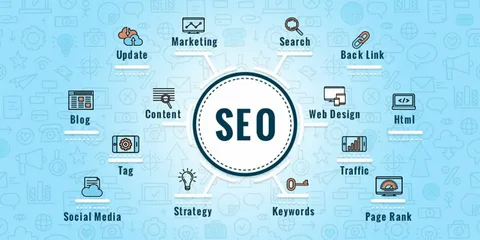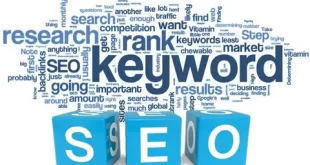Introduction
In the expansive realm of digital marketing, the strategies of SEO (Search Engine Optimization) and digital advertising stand as pillars, each with its unique approach to enhancing online visibility. This introduction serves as a guide, shedding light on the fundamental differences between SEO and digital advertising, dissecting their core principles, and illuminating how businesses can strategically leverage these approaches for optimal results. As we embark on this exploration, we unravel the complexities that define these methodologies, providing a foundation for informed decision-making in the dynamic landscape of online marketing.

Table of Contents
Navigating the Digital Landscape: Unraveling the Nuances Between SEO and Digital Advertising
Understanding the Digital Marketing Tapestry
In the ever-evolving world of digital marketing, businesses navigate a complex tapestry woven with various strategies to enhance online visibility. Among the key players in this landscape are SEO (Search Engine Optimization) and digital advertising, each wielding distinct methodologies. This comprehensive guide aims to demystify the intricacies, providing a deep dive into the differences between SEO and digital advertising. From the nature of traffic generation to cost structures, timelines for results, and the impact on user experience, we dissect these strategies to equip businesses with the knowledge needed for strategic decision-making.
1. Nature of Traffic Generation: Organic vs. Paid
SEO: The Organic Odyssey
- Overview: SEO revolves around organic methods to boost a website’s visibility in search engine results.
- Mechanics: It involves optimizing on-page elements, creating quality content, and building high-quality backlinks.
- Traffic Generation: Organic traffic is cultivated over time as a result of these efforts.
Digital Advertising: The Paid Expedite
- Overview: Digital advertising relies on paid strategies for immediate visibility.
- Mechanics: Paid search ads, display advertising, and social media ads are prominent forms of digital advertising.
- Traffic Generation: Immediate visibility is achieved, but it is directly tied to the budget allocated for the campaign.
Insights: SEO and digital advertising represent two distinct paths to generating online traffic. SEO is a long-term, organic growth strategy, while digital advertising offers immediate visibility through paid methods.
2. Cost Structure: Investment in Visibility
SEO: The Patient Investment
- Costs: Costs are associated with hiring SEO experts, creating quality content, and maintaining website infrastructure.
- Timeline: Results take time, and ongoing efforts are required for sustained visibility.
- Longevity: Results, once achieved, contribute to long-term visibility.
Digital Advertising: The Direct Expense
- Costs: Direct costs include bidding on keywords, setting budgets, and paying for impressions or clicks.
- Timeline: Immediate results are achieved during the campaign duration.
- Longevity: Visibility is tied to the duration of the advertising campaign.
Insights: SEO requires a patient investment with long-term benefits, while digital advertising involves direct expenses for immediate, short-term visibility.

3. Timeline for Results: Patience vs. Immediacy
SEO: The Waiting Game
- Timeline: Weeks or months may elapse before SEO efforts manifest improvements in search rankings and organic traffic.
- Factors: Factors include competition, algorithm changes, and the scale of SEO efforts.
- Sustainability: Results, once achieved, are sustainable over the long term.
Digital Advertising: The Quick Turnaround
- Timeline: Ads are displayed almost immediately after the campaign launch.
- Factors: Immediate visibility is achieved based on the campaign duration and budget.
- Sustainability: Results are tied to the active duration of the advertising campaign.
Insights: SEO demands patience, offering sustainable results, while digital advertising provides quick visibility with results tied to the campaign’s active duration.
4. Long-Term vs. Short-Term Strategy: Building Foundations vs. Instant Impact
SEO: Building Foundations for Tomorrow
- Strategy: A long-term strategy that builds a website’s authority and visibility over time.
- Focus: Emphasizes quality content, backlink building, and on-page optimizations.
- Goals: Aims for sustained, organic growth and credibility.
Digital Advertising: Instant Impact for Today
- Strategy: Often considered a short-term strategy to achieve specific campaign goals.
- Focus: Targets immediate visibility through paid methods and specific campaign objectives.
- Goals: Immediate results for short-term objectives.
Insights: SEO is a foundational, long-term strategy, while digital advertising is an impactful, short-term approach for immediate goals.
5. Visibility Placement: Organic Rankings vs. Paid Positions
SEO: The Quest for Organic Prominence
- Focus: Optimizing to rank higher in organic (non-paid) search results.
- Placement: Visibility is earned based on the relevance and authority of the website.
- Method: Primarily focuses on user-initiated searches.
Digital Advertising: The Calculated Placement
- Focus: Paying for ad placements to achieve immediate visibility.
- Placement: Ads can appear at the top, bottom, or side of search results, or on various websites and social media platforms.
- Method: Targets specific audiences based on demographics, interests, and behaviors.
Insights: SEO strives for organic prominence through relevance and authority, while digital advertising strategically places paid ads for immediate visibility.
6. User Intent: User Searches vs. Broad Targeting
SEO: Meeting User Intent Through Searches
- Targeting: Focuses on users actively searching for information, products, or services related to specific keywords.
- Emphasis: Meeting user intent with relevant content and solutions.
- Method: Primarily user-initiated searches.
Digital Advertising: Broad Targeting Beyond Searches
- Targeting: Targets users based on demographics, interests, and behaviors.
- Emphasis: Broad targeting to capture a wider audience.
- Method: User-initiated searches and broader audience targeting.
Insights: SEO targets specific user searches, aligning with user intent, while digital advertising employs broader targeting strategies to reach diverse audiences.
7. Flexibility and Control: Adapting to Change
SEO: Adapting to Algorithm Shifts
- Control: Changes to search algorithms are beyond immediate control.
- Adaptation: Strategies require ongoing adaptation to algorithm updates.
- Dependency: Not platform-dependent.
Digital Advertising: Campaigns with Precision Control
- Control: Offers more control over campaign settings, targeting, and budget allocation.
- Adaptation: Campaigns can be adjusted quickly based on real-time performance.
- Dependency: Platform-dependent, reliant on specific advertising networks.
Insights: SEO requires ongoing adaptation to algorithm shifts, while digital advertising provides precise control over campaign settings and adjustments.
8. Credibility and Trust Building: Authority vs. Immediate Impact
SEO: Establishing Credibility Over Time
- Credibility: Builds credibility and trust over time as the website gains authority.
- Method: Focuses on the overall website quality, content relevance, and user experience.
- Timeframe: Establishes long-term trust.
Digital Advertising: Immediate Visibility, Varied Trust Impact
- Credibility: Immediate visibility, but may not inherently contribute to long-term trust-building.
- Method: Requires compelling ad creatives to capture attention.
- Timeframe: Impact varies based on the campaign duration.
Insights: SEO establishes credibility over time through authority, while digital advertising offers immediate visibility with varied impacts on trust.
9. User Experience Impact: Quality Content vs. Compelling Creatives
SEO: Quality Content for User Experience
- Focus: Improving overall website quality, content relevance, and user experience.
- Method: Strives for a positive user experience to enhance organic rankings.
- Impact: Influences the overall quality of the website.
Digital Advertising: Compelling Creatives for Attention
- Focus: Requires compelling ad creatives to capture attention.
- Method: Directly impacts the user experience during ad interactions.
- Impact: Influences the immediate perception of the advertised content.
Insights: SEO focuses on the website’s overall quality for user experience, while digital advertising relies on compelling creatives for immediate attention.

10. Dependency on Platforms: Platform Independence vs. Platform Reliance
SEO: Platform Independence
- Dependency: Not platform-dependent; focuses on optimizing for various search engines.
- Method: Ensures broader visibility across different search engine platforms.
Digital Advertising: Platform Reliance
- Dependency: Platform-dependent, as ads are displayed on specific platforms.
- Method: Targets specific platforms like Google Ads, Facebook Ads, or other advertising networks.
Insights: SEO is platform-independent, while digital advertising relies on specific platforms for ad placements and visibility.
Conclusion: Crafting a Holistic Digital Strategy
As we unravel the distinctions between SEO and digital advertising, it becomes evident that each strategy plays a pivotal role in the digital marketing arsenal. SEO lays the foundation for long-term credibility and organic growth, while digital advertising offers immediate visibility and precise control over campaigns. The key lies in crafting a holistic digital strategy that leverages the strengths of both approaches, aligning with business goals, user behavior, and the ever-shifting dynamics of the digital landscape. By understanding these nuances, businesses can navigate the digital marketing tapestry with informed decision-making, ensuring a strategic blend of organic and paid visibility for sustained success in the online realm.
Frequently Asked Questions (FAQs) – Understanding the Differences Between SEO and Digital Advertising
Q1: What is the primary difference between SEO and digital advertising?
A: SEO (Search Engine Optimization) focuses on optimizing a website to improve its visibility in organic search results, while digital advertising involves paid strategies to display ads and achieve immediate visibility.
Q2: How does the cost structure differ between SEO and digital advertising?
A: SEO incurs costs related to content creation, website maintenance, and hiring SEO experts. Digital advertising involves direct costs for running ads, such as bidding on keywords and paying for impressions or clicks.
Q3: Which strategy provides quicker results, SEO or digital advertising?
A: Digital advertising provides quicker results, as ads are displayed almost immediately after a campaign is launched. SEO, being an organic strategy, takes time, and results may take weeks or months to manifest.
Q4: Are the results of SEO sustainable in the long term?
A: Yes, the results of SEO are often sustainable in the long term. Once a website gains authority and visibility through SEO efforts, it can maintain organic rankings over an extended period.
Q5: How does user intent differ between SEO and digital advertising?
A: SEO targets users actively searching for information, products, or services related to specific keywords. Digital advertising involves broader targeting based on demographics, interests, and behaviors, capturing a wider audience.
Q6: Can both SEO and digital advertising be part of the same marketing strategy?
A: Yes, an effective digital marketing strategy often includes both SEO and digital advertising. SEO provides long-term, organic growth, while digital advertising offers immediate visibility and precise control over campaigns.
Q7: How do changes in search algorithms affect SEO?
A: Changes in search algorithms are beyond immediate control in SEO. SEO strategies require ongoing adaptation to algorithm updates to maintain and improve organic visibility.
Q8: Does digital advertising contribute to long-term trust-building?
A: While digital advertising provides immediate visibility, it may not inherently contribute to long-term trust-building. Trust is often built over time, and digital advertising is more focused on achieving short-term campaign goals.
Q9: Are SEO and digital advertising suitable for businesses of all sizes?
A: Yes, both SEO and digital advertising are suitable for businesses of all sizes. The strategies can be tailored to fit the specific goals, budget, and target audience of each business.
Q10: Can I run digital advertising campaigns without expertise?
A: While it’s possible to run digital advertising campaigns without expertise, it is advisable to have a solid understanding of the platforms, targeting options, and ad creatives to maximize the effectiveness of the campaigns.
Q11: How do I measure the success of SEO efforts?
A: Success in SEO is measured through various metrics such as organic traffic, keyword rankings, conversion rates, and user engagement. Tools like Google Analytics can provide valuable insights into the performance of SEO efforts.
Q12: Can SEO and digital advertising be outsourced to professionals?
A: Yes, both SEO and digital advertising can be outsourced to professionals and agencies with expertise in these areas. Hiring specialists can ensure that the strategies are implemented effectively for optimal results.
 Nextezone: Igniting Tomorrow's Potential with Innovation Today Innovate. Explore. Elevate. Nextezone – Where Vision Meets Innovation.
Nextezone: Igniting Tomorrow's Potential with Innovation Today Innovate. Explore. Elevate. Nextezone – Where Vision Meets Innovation.
